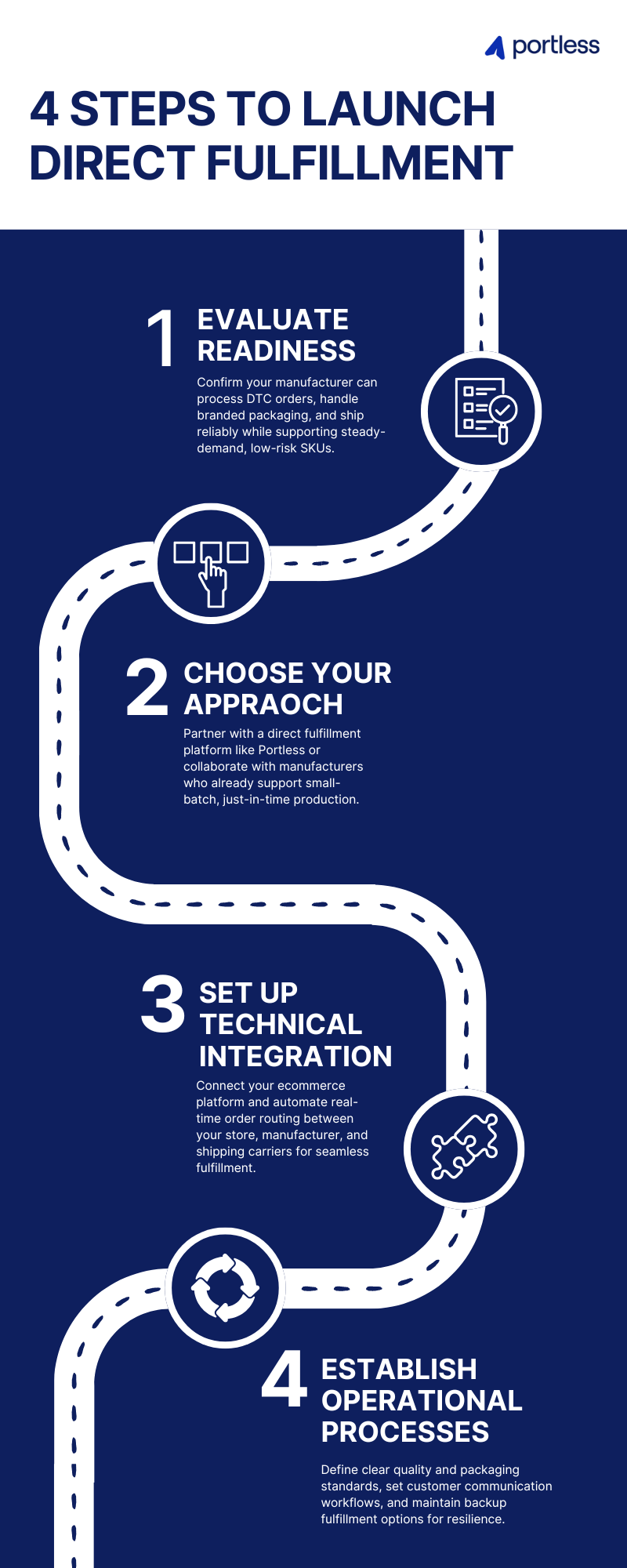Direct fulfillment is a shipping model where products move straight from the manufacturer to the end customer without intermediate warehousing. This approach eliminates storage costs and reduces handling touchpoints in your supply chain. Your products ship directly to customers as soon as they’re produced, creating a simple path from factory to doorstep.
When a customer places an order on your website or marketplace, it’s transmitted directly to your manufacturer, who handles picking, packing, and shipping. This creates a just-in-time inventory model, allowing you to sell products almost immediately after production.
Ready to transform your fulfillment strategy?
Book a demo to see how Portless can help you implement direct fulfillment from manufacturers to customers worldwide.
Direct-to-consumer brands use direct fulfillment to ship products straight from manufacturing partners to customers. When a customer orders from your website, that information routes automatically to your manufacturer in real time. Your manufacturer then prepares the package with your branded materials and ships directly to your customer.
This effectively turns your manufacturing facility into a direct fulfillment center, eliminating the need for intermediate warehousing. Integration platforms connect your ecommerce store, manufacturer systems, and shipping carriers to create an efficient flow of information.
Brands selling on platforms like Shopify, Walmart, or TikTok Shop can leverage direct fulfillment to ship products straight from manufacturers under their own brand identity.
Unlike marketplace-managed logistics programs, direct fulfillment gives brands full control over packaging, data, and customer experience. It’s ideal for sellers focused on building long-term brand equity and margin efficiency rather than relying on third-party marketplaces for fulfillment infrastructure.
In B2B contexts, direct fulfillment means suppliers ship products directly to retailers or business customers. This often relies on EDI systems that transmit purchase orders and shipping notices electronically.
Consumer direct fulfillment in B2B contexts requires compliance with retailer standards for labeling, packaging, and delivery timing — helping manufacturers meet major retailer guidelines while maintaining direct control over fulfillment.
Direct fulfillment gives you greater control over production timing while eliminating warehouse costs. Traditional 3PLs provide a middle ground but still require inventory investment before sales.
Direct fulfillment represents a global 3PL alternative, combining the control of first-party logistics with the automation of third-party providers. With platforms like Portless, brands gain end-to-end visibility from production to doorstep without multiple intermediaries.
Direct fulfillment improves cash flow by reducing the time between production and sale. Traditional models require buying inventory months before selling it; direct fulfillment lets you sell days after production.
Storage costs disappear — no warehouse rent, staff, or insurance. According to McKinsey, reducing working capital tied to inventory is one of the most effective ways to boost financial performance.
This factory-direct fulfillment approach creates a just-in-time supply chain, turning frozen capital into cash that fuels growth.
Direct order fulfillment simplifies logistics by removing warehousing steps and reducing handling. Fewer handoffs mean fewer errors, less damage, and faster delivery.
Quality control improves when products ship straight from the source, with manufacturers taking responsibility for accuracy and condition.
Operational improvements include:
Global reach becomes easier when you can ship internationally from your manufacturing base. You can test new markets without building warehouses or distribution centers.
Scalability also improves — no warehouse limits or capital tied up in stock. You can add products or ramp up for peak seasons without extra infrastructure.
See how Portless can help you unlock global markets
Discover how Portless works to enable direct shipping from manufacturers to customers in over 55 countries worldwide.

Direct fulfillment works best for made-to-order or long-shelf-life products where slightly longer shipping times won’t hurt the customer experience.
It’s ideal for international brands or those focused on cash flow optimization and rapid product testing.
Transform your logistics strategy today
Talk to our team about how Portless can help you implement direct fulfillment from manufacturers to customers worldwide.
How much does direct fulfillment cost compared to traditional warehousing?
Direct fulfillment typically costs 15–30% less than traditional models because you eliminate warehouse fees and reduce carrying costs, though per-package shipping may be slightly higher.
What are typical delivery times for international direct fulfillment orders?
Usually 5–12 days from Asia to North America or Europe; domestic direct fulfillment can achieve 2–5 days.
Can direct fulfillment integrate with my existing ecommerce platform?
Yes, most providers connect with Shopify and WooCommerce.
How are customer returns handled?
Returned items typically go to a designated processing center for inspection and refund management, keeping manufacturing operations uninterrupted.
How do I maintain brand consistency with direct fulfillment shipping?
Provide manufacturers with branded packaging and inserts, and audit shipments regularly to ensure quality and presentation.
What types of products work best with direct fulfillment?
Products with stable demand, longer shelf life, and higher margins. For example, electronics, apparel, home goods, and beauty items — they perform best with factory-direct fulfillment models.